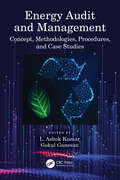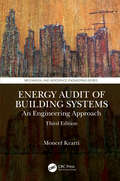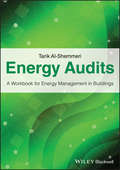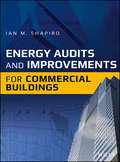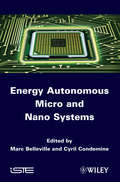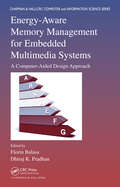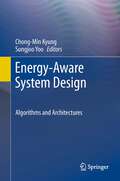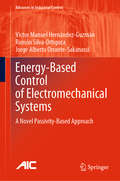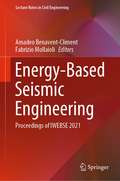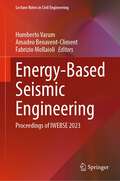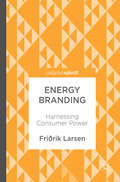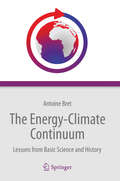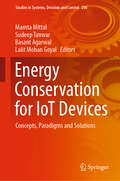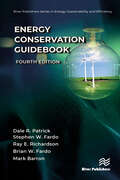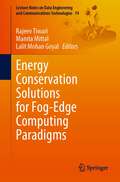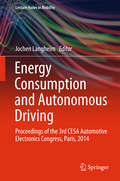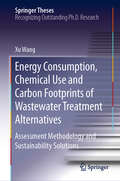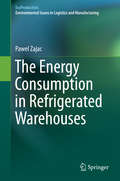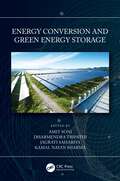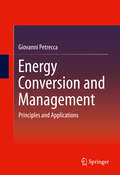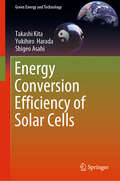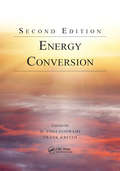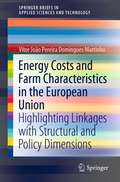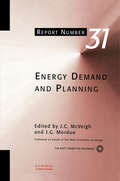- Table View
- List View
Energy Audit and Management: Concept, Methodologies, Procedures, and Case Studies
by L. Ashok Kumar Gokul GanesanThis book describes the energy management concepts, energy audit principles, resource efficiency, and other energy conservation opportunities involved in different sectors across varied industries. Real-time case studies from various large industrial sectors, like cement, paper and pulp, refineries, manufacturing, garments and textile processing, power plants, and other MSME industrial sectors with cross functional energy conservation opportunities, are included. It also describes the future scope of energy auditing and management including IoT and data analytics. It also helps to gather the energy generated and utilization, energy conservation, and other process related data. Features: Provides entire coverage of energy management and audit concepts. Explores energy audit methodologies and energy saving initiatives. Incorporates current technologies like machine learning, IoT, data analytics in energy audit for reliability improvement. Includes case studies covering detailed energy saving calculation with investment pay back calculations. This book is aimed at researchers, professionals, and graduate students in electrical engineering, power systems, energy systems, and renewable energy.
Energy Audit of Building Systems: An Engineering Approach, Third Edition (Mechanical and Aerospace Engineering Series)
by Moncef KrartiUpdated to include recent advances, this third edition presents strategies and analysis methods for conserving energy and reducing operating costs in residential and commercial buildings. The book explores the latest approaches to measuring and improving energy consumption levels, with calculation examples and Case Studies. It covers field testing, energy simulation, and retrofit analysis of existing buildings. It examines subsystems—such as lighting, heating, and cooling—and techniques needed for accurately evaluating them. Auditors, managers, and students of energy systems will find this book to be an invaluable resource for their work. Explores state-of-the-art techniques and technologies for reducing energy combustion in buildings. Presents the latest energy efficiency strategies and established methods for energy estimation. Provides calculation examples that outline the application of the methods described. Examines the major building subsystems: lighting, heating, and air-conditioning. Addresses large-scale retrofit analysis approaches for existing building stocks. Introduces the concept of energy productivity to account for the multiple benefits of energy efficiency for buildings. Includes Case Studies to give readers a realistic look at energy audits. Moncef Krarti has vast experience in designing, testing, and assessing innovative energy efficiency and renewable energy technologies applied to buildings. He graduated from the University of Colorado with both MS and PhD in Civil Engineering. Prof. Krarti directed several projects in designing energy-efficient buildings with integrated renewable energy systems. He has published over 3000 technical journals and handbook chapters in various fields related to energy efficiency, distribution generation, and demand-side management for the built environment. Moreover, he has published several books on building energy-efficient systems. Prof. Krarti is Fellow member to the American Society for Mechanical Engineers (ASME), the largest international professional society. He is the founding editor of the ASME Journal of Sustainable Buildings & Cities Equipment and Systems. Prof. Krarti has taught several different courses related to building energy systems for over 20 years in the United States and abroad. As a professor at the University of Colorado, Prof. Krarti has been managing the research activities of an energy management center at the school with an emphasis on testing and evaluating the performance of mechanical and electrical systems for residential and commercial buildings. He has also helped the development of similar energy efficiency centers in other countries, including Brazil, Mexico, and Tunisia. In addition, Prof. Krarti has extensive experience in promoting building energy technologies and policies overseas, including the establishment of energy research centers, the development of building energy codes, and the delivery of energy training programs in several countries.
Energy Audits: A Workbook for Energy Management in Buildings
by Tarik Al-ShemmeriEnergy efficiency is today a crucial topic in the built environment - for both designers and managers of buildings. This increased interest is driven by a combination of new regulations and directives within the EU and worldwide to combat global warming. All buildings now must now acquire and display an EPC (energy performance certificate), a rating similar to the A–G rating given to white goods. But in order to understand how to be more efficient in energy use, you need first to understand the mechanisms of both energy requirements and how energy is used in buildings. Energy Audits: a workbook for energy management in buildings tackles the fundamental principles of thermodynamics through day-to-day engineering concepts and helps students understand why energy losses occur and how they can be reduced. It provides the tools to measure process efficiency and sustainability in power and heating applications, helping engineers to recognize why energy losses occur and how they can be reduced utilizing familiar thermodynamic principles. The author describes the sources of energy available today; explains how energy is used in buildings – and how energy is lost - and how this can be controlled and reduced. Investments in energy efficiency are considered for a number of case studies conducted on real buildings The book explains the theory; illustrates it with case studies and worked examples; and then tests students’ understanding with tutorial problems. This is an invaluable resource for students on engineering and building courses where energy management is now a core topic.
Energy Audits and Improvements for Commercial Buildings
by Ian M. ShapiroThe Intuitive Guide to Energy Efficiency and Building Improvements Energy Audits and Improvements for Commercial Buildings provides a comprehensive guide to delivering deep and measurable energy savings and carbon emission reductions in buildings. Author Ian M. Shapiro has prepared, supervised, and reviewed over 1,000 energy audits in all types of commercial facilities, and led energy improvement projects for many more. In this book, he merges real-world experience with the latest standards and practices to help energy managers and energy auditors transform energy use in the buildings they serve, and indeed to transform their buildings. Set and reach energy reduction goals, carbon reduction goals, and sustainability goals Dramatically improve efficiency of heating, cooling, lighting, ventilation, water and other building systems Include the building envelope as a major factor in energy use and improvements Use the latest tools for more thorough analysis and reporting, while avoiding common mistakes Get up to date on current improvements and best practices, including management of energy improvements, from single buildings to large building portfolios, as well as government and utility programs Photographs and drawings throughout illustrate essential procedures and improvement opportunities. For any professional interested in efficient commercial buildings large and small, Energy Audits and Improvements for Commercial Buildings provides an accessible, complete, improvement-focused reference.
Energy Autonomous Micro and Nano Systems
by Marc Belleville Cyril CondemineProviding a detailed overview of the fundamentals and latest developments in the field of energy autonomous microsystems, this book delivers an in-depth study of the applications in the fields of health and usage monitoring in aeronautics, medical implants, and home automation, drawing out the main specifications on such systems. Introductory information on photovoltaic, thermal and mechanical energy harvesting, and conversion, is given, along with the latest results in these fields. This book also provides a state of the art of ultra-low power sensor interfaces, digital signal processing and wireless communications. In addition, energy optimizations at the sensor node and sensors network levels are discussed, thus completing this overview. This book details the challenges and latest techniques available to readers who are interested in this field. A major strength of this book is that the first three chapters are application orientated and thus, by setting the landscape, introduce the technical chapters. There is also a good balance between the technical application, covering all the system-related aspects and, within each chapter, details on the physics, materials and technologies associated with electronics. Contents Introduction. Introduction to Energy Autonomous Micro and Nano Systems and Presentation of Contributions, Marc Belleville and Cyril Condemine. 1. Sensors at the Core of Building Control, Gilles Chabanis, Laurent Chiesi, Hynek Raisigel, Isabelle Ressejac and Véronique Boutin. 2. Toward Energy Autonomous MedicalImplants, Raymond Campagnolo and Daniel Kroiss. 3. Energy Autonomous Systems in Aeronautic Applications, Thomas Becker, Jirka Klaue and Martin Kluge. 4. Energy Harvesting by Photovoltaic Effect, Emmanuelle Rouvière, Simon Perraud, Cyril Condemine and Guy Waltisperger. 5. Mechanical Energy Harvesting, Ghislain Despesse, Jean Jacques Chaillout, Sébastien Boisseau and Claire Jean-Mistral. 6. Thermal Energy Harvesting, Tristan Caroff, Emmanuelle Rouvière and Jérôme Willemin. 7. Lithium Micro-Batteries, Raphaël Salot. 8. Ultra-Low-Power Sensors, Pascal Nouet, Norbert Dumas, Laurent Latorre and Frédérick Mailly. 9. Ultra-Low-Power Signal Processing in Autonomous Systems, Christian Piguet. 10. Ultra-Low-Power Radio Frequency Communications and Protocols, Eric Mercier. 11. Energy Management in an Autonomous Microsystem, Jean-Frédéric Christmann, Edith Beigne, Cyril Condemine, Jérôme Willemin and Christian Piguet. 12. Optimizing Energy Efficiency of Sensor Networks, Olivier Sentieys and Olivier Berder.
Energy-Aware Memory Management for Embedded Multimedia Systems: A Computer-Aided Design Approach (Chapman & Hall/CRC Computer and Information Science Series)
by Florin Balasa Dhiraj K. PradhanEnergy-Aware Memory Management for Embedded Multimedia Systems: A Computer-Aided Design Approach presents recent computer-aided design (CAD) ideas that address memory management tasks, particularly the optimization of energy consumption in the memory subsystem. It explains how to efficiently implement CAD solutions, including theoretical methods an
Energy-Aware System Design
by Chong-Min Kyung Sungjoo YooPower consumption becomes the most important design goal in a wide range of electronic systems. There are two driving forces towards this trend: continuing device scaling and ever increasing demand of higher computing power. First, device scaling continues to satisfy Moore's law via a conventional way of scaling (More Moore) and a new way of exploiting the vertical integration (More than Moore). Second, mobile and IT convergence requires more computing power on the silicon chip than ever. Cell phones are now evolving towards mobile PC. PCs and data centers are becoming commodities in house and a must in industry. Both supply enabled by device scaling and demand triggered by the convergence trend realize more computation on chip (via multi-core, integration of diverse functionalities on mobile SoCs, etc.) and finally more power consumption incurring power-related issues and constraints. Energy-Aware System Design: Algorithms and Architectures provides state-of-the-art ideas for low power design methods from circuit, architecture to software level and offers design case studies in three fast growing areas of mobile storage, biomedical and security. Important topics and features: - Describes very recent advanced issues and methods for energy-aware design at each design level from circuit and architecture to algorithm level, and also covering important blocks including low power main memory subsystem and on-chip network at architecture level - Explains efficient power conversion and delivery which is becoming important as heterogeneous power sources are adopted for digital and non-digital parts - Investigates 3D die stacking emphasizing temperature awareness for better perspective on energy efficiency - Presents three practical energy-aware design case studies; novel storage device (e.g., solid state disk), biomedical electronics (e.g., cochlear and retina implants), and wireless surveillance camera systems. Researchers and engineers in the field of hardware and software design will find this book an excellent starting point to catch up with the state-of-the-art ideas of low power design.
Energy-Based Control of Electromechanical Systems: A Novel Passivity-Based Approach (Advances in Industrial Control)
by Victor Manuel Hernández-Guzmán Ramón Silva-Ortigoza Jorge Alberto Orrante-SakanassiThis book introduces a passivity-based approach which simplifies the controller design task for AC-motors. It presents the application of this novel approach to several classes of AC motors, magnetic levitation systems, microelectromechanical systems (MEMS) and rigid robot manipulators actuated by AC motors. The novel passivity-based approach exploits the fact that the natural energy exchange existing between the mechanical and the electrical subsystems allows the natural cancellation of several high order terms during the stability analysis. This allows the authors to present some of the simplest controllers proposed in scientific literature, but provided with formal stability proofs. These simple control laws will be of use to practitioners as they are robust with respect to numerical errors and noise amplification, and are provided with tuning guidelines. Energy-based Control of Electromechanical Systems is intended for both theorists and practitioners. Therefore, the stability proofs are not based on abstract mathematical ideas but Lyapunov stability theory. Several interpretations of the proofs are given along the body of the book using simple energy ideas and the complete proofs are included in appendices. The complete modeling of each motor studied is also presented, allowing for a thorough understanding.Advances in Industrial Control reports and encourages the transfer of technology in control engineering. The rapid development of control technology has an impact on all areas of the control discipline. The series offers an opportunity for researchers to present an extended exposition of new work in all aspects of industrial control.
Energy-Based Seismic Engineering: Proceedings of IWEBSE 2021 (Lecture Notes in Civil Engineering #155)
by Amadeo Benavent-Climent Fabrizio MollaioliThis volume gathers the latest advances, innovations, and applications in the field of seismic engineering, as presented by leading researchers and engineers at the 1st International Workshop on Energy-Based Seismic Engineering (IWEBSE), held in Madrid, Spain, on May 24-26, 2021. The contributions cover a diverse range of topics, including energy-based EDPs, damage potential of ground motion, structural modeling in energy-based damage assessment of structures, energy dissipation demand on structural components, innovative structures with energy dissipation systems or seismic isolation, as well as seismic design and analysis. Selected by means of a rigorous peer-review process, they will spur novel research directions and foster future multidisciplinary collaborations.
Energy-Based Seismic Engineering: Proceedings of IWEBSE 2023 (Lecture Notes in Civil Engineering #236)
by Humberto Varum Amadeo Benavent-Climent Fabrizio MollaioliThis book gathers the latest advances, innovations, and applications in the field of seismic engineering, as presented by leading researchers and engineers at the 2nd International Workshop on Energy-Based Seismic Engineering (IWEBSE), held in Porto, Portugal, on July 3–6, 2023. The book covers a diverse range of topics, including energy-based EDPs, damage potential of ground motion, structural modeling in energy-based damage assessment of structures, energy dissipation demand on structural components, innovative structures with energy dissipation systems or seismic isolation, as well as seismic design and analysis. Selected by means of a rigorous peer-review process, they will spur novel research directions and foster future multidisciplinary collaborations.
Energy Branding
by Friðrik LarsenDemonstrating the potential of building strong brands in the energy sector, this book explores the challenges of shifting the perception of energy from a commodity business into a consumer brand. Energy suppliers are increasingly being met with skepticism, indicating the need for a greater focus on marketing and branding in the energy industry. The author examines both perspectives of energy as a commodity business and a consumer brand, as well as the perception of energy consumers across Europe. Topics discussed include green energy, the liberalisation of the electricity industry, and the relationship between consumers and executives in the energy market. One of the first of its kind, this book offers a unique and innovative study of the development of branding in the energy industry, and sheds light on future marketing strategies.
The Energy-Climate Continuum
by Antoine BretThis book puts the debates about the energy-climate continuum on a scientific ground! It is a must-read for everyone, who wants to understand how intimately the energy and climate debates are linked to each other, and who wants to participate in these omnipresent discussions. Antoine Bret explains in his book how fossil fuels became indispensable for our society. He carefully explains how and why this impacts the earth's climate. And he points out that all available fossil fuels will sooner or later be used up. Therefore, he introduces and discusses the alternatives, which are currently considered. The book is divided into three parts. The first part explains the problem and where we stand today, the second part critically discusses possible elements of solution. The third part illustrates historic case studies, containing both warning as well as encouraging examples of societies at turning points. This book is a careful introduction to these topics. The basic science behind the problem and the debates are introduced in an understandable and nicely readable fashion. Facts are illustrated with simple back-on-the-envelope calculations, providing a good feeling for orders of magnitudes. A rich appendix provides additional background information for the interested readers. In this way, the book can even be a valuable resource for introductory university courses in physics, climate science, natural science and many more subjects. This book is a real conversation starter and can be recommended to everyone, specialist or non-specialist, who wants to understand the actual energy-climate debates and maybe even involve.
Energy Conservation for IoT Devices: Concepts, Paradigms and Solutions (Studies in Systems, Decision and Control #206)
by Mamta Mittal Sudeep Tanwar Basant Agarwal Lalit Mohan GoyalThis book addresses the Internet of Things (IoT), an essential topic in the technology industry, policy, and engineering circles, and one that has become headline news in both the specialty press and the popular media. The book focuses on energy efficiency concerns in IoT and the requirements related to Industry 4.0. It is the first-ever “how-to” guide on frequently overlooked practical, methodological, and moral questions in any nations’ journey to reducing energy consumption in IoT devices. The book discusses several examples of energy-efficient IoT, ranging from simple devices like indoor temperature sensors, to more complex sensors (e.g. electrical power measuring devices), actuators (e.g. HVAC room controllers, motors) and devices (e.g. industrial circuit-breakers, PLC for home, building or industrial automation). It provides a detailed approach to conserving energy in IoT devices, and comparative case studies on performance evaluation metrics, state-of-the-art approaches, and IoT legislation.
Energy Conservation Guidebook (River Publishers Series in Energy Sustainability and Efficiency)
by Dale R. Patrick Stephen W. Fardo Ray E. Richardson Brian W. Fardo Mark BarronEfficient energy management and effective conservation procedures have been very important considerations for our society for many years. An oil embargo in the 1970s and early 1980s brought about a new awareness of energy conservation. Because of various factors like loss of tax credits and efficiency standards imposed by the government, public interest dropped considerably in regard to energy conservation. A revival in energy conservation among the general public occurred following the Persian Gulf War in the early 1990s. What does the 21st century hold? Conflicts in the Middle East, high prices for petroleum, and increasing population worldwide will all be significant influences on energy and its conservation. Considerable discussion of climate change, global warming, and increased concerns in regard to our electricity supply have provided motivation for building energy demand to be more flexible. Energy Management and Conservation, Fourth Edition, provides a very practical discussion of how energy can be managed and saved in most types of buildings. This edition not only updates the previous edition but adds updated content concerning energy cost reduction/going green to improve the environment. The authors of this book have written several books that use the systems approach. Through the use of the systems approach, the reader will be able to grasp how different parts of a building fit together to form a unit that uses energy efficiently. This text provides a thorough and practical discussion of the operation of systems that are found in most types of buildings. Each system is discussed with energy management and conservation in mind/going green to save money and improve the environment. There are many ways to manage a building to accomplish efficient energy conservation. Several of the chapters have checklists at the end to summarize ways of conserving energy that relate to the chapter. Important changes in this edition include coverage of governmental requirements from agencies such as Environmental Protection Agency (EPA), United States Department of Energy (USDOE), and American Society of Refrigerating, Heating and Air-Conditioning Engineering (ASHRAE), updated as of 2022 standards. Instrumentation updates include types of sensors and the concept of "smart" devices such as meters. Addition of computer building maintenance management systems and new updates for renewable energy resources are included. Enhancements to existing systems content (such as variable frequency drives for pumps) have been carefully added.
Energy Conservation Solutions for Fog-Edge Computing Paradigms (Lecture Notes on Data Engineering and Communications Technologies #74)
by Rajeev Tiwari Mamta Mittal Lalit Mohan GoyalThis book focuses on energy efficiency concerns in fog–edge computing and the requirements related to Industry 4.0 and next-generation networks like 5G and 6G. This book guides the research community about practical approaches, methodological, and moral questions in any nations’ journey to conserve energy in fog–edge computing environments. It discusses a detailed approach required to conserve energy and comparative case studies with respect to various performance evaluation metrics, such as energy conservation, resource allocation strategies, task allocation strategies, VM migration, and load-sharing strategies with state-of-the-art approaches, with fog and edge networks.
Energy Consumption and Autonomous Driving
by Jochen LangheimThis volume collects selected papers of the 3rd CESA Automotive Electronics Congress, Paris, 2014. CESA is the most important automotive electronics conference in France. The topical focus lies on state-of-the-art automotive electronics with respect to energy consumption and autonomous driving. The target audience primarily comprises industry leaders and research experts in the automotive industry.
Energy Consumption, Chemical Use and Carbon Footprints of Wastewater Treatment Alternatives: Assessment Methodology and Sustainability Solutions (Springer Theses)
by Xu WangThis thesis focuses on the energy, chemical and carbon implications of diverse wastewater treatment alternatives, and offers effective solutions for wastewater treatment plants (WWTPs) to achieve sustainability goals. The author first uses the life cycle philosophy to explore the environmental performance of several representative wastewater treatment systems, and then proposes a refined assessment framework, accompanying analytical toolkit and case study for further quantifying the environmental sustainability of various wastewater management scenarios. Allowing readers to gain a better understanding of the existing wastewater treatment technologies from a sustainability perspective, this book helps decision makers identify promising approaches to the environmentally friendly operation of WWTPs and make infrastructure investments that are appropriate for future changing conditions.
The Energy Consumption in Refrigerated Warehouses
by Pawel ZajacThis book explores the philosophical understanding of the "energy consumption" in warehousing process that can be found in the literature. It presents known technical solutions that, if they are used in cold storage rooms, can effectively reduce energy consumption: through lower power consumption and/or energy recovery, such as the use of photovoltaic panels. The final part of the book explores the problems discussed on the basis of a concrete example - a project involving energy recovery in a refrigerated warehouse. This publication also describes the design of refrigerated warehouses, taking into account their energy intensity. In the case of logistic warehousing systems, the pallets in warehouses can offer a source of energy - namely of the potential energy stored in the loads on the shelves. Given that today's construction warehouses have heights on the order of several tens of meters, that energy can be considerable. In the case of refrigerated warehouses and cold storage facilities, it is necessary to monitor the stored goods in order to maintain a constant freezing temperature, in keeping with the requirements of the HACCP system. Inevitably, this calls for constant cooling of the air inside the warehouse, and thus produces a fixed, high and constant level of energy usage. And, just as in any other context, it becomes important to identify methods for reducing energy consumption.
Energy Conversion and Green Energy Storage
by Amit SoniEnergy Conversion and Green Energy Storage presents recent developments in renewable energy conversion and green energy storage. Covering technical expansions in renewable energy and applications, energy storage, and solar photovoltaics, the book features chapters written by global experts in the field. Providing insights related to various forms of renewable energy, the book discusses developments in solar photovoltaic applications. The book also includes simulation codes and programs, such as Wien2k code, VASP code, and MATLAB®. The book serves as a useful reference for researchers, graduate students, and engineers in the field of energy.
Energy Conversion and Management
by Giovanni PetreccaThis book provides an overall view of energy conversion and management in industry and in buildings by following the streams of energy from the site boundaries to the end users. Written for an audience of both practitioners and faculty/students, Energy Conversion and Management: Principles and Applications presents general principles of energy conversion and energy sources, both traditional and renewable, in a broad range of facilities such as electrical substations, boiler plants, heat and power plants, electrical networks, thermal fluid distributions lines and insulations, pumps and fans, air compressor systems, cooling plants, HVAC, lighting, and heat recovery plants. The book also examines principles of energy auditing and accounting, the correlation between energy and environment, and includes detail on the economic analysis of energy saving investment and education in the field of energy. This book also: · Explores a broad array of power generation and distribution facilities around the concept of energy conversion, from traditional and renewable sources, correlating many apparently disparate topics · Elucidates fundamental formulas and information-rich figures to help readers in solving any practical energy conversion problems · Emphasizes a holistic perspective on energy conversion and management with a vision of each application as a system beyond its individual elements · Includes a set of Key Performance Index using metrics applicable to energy systems brought into operation over the past 30 years · Gives a set of basic formulas and data that are the essentials of energy conversion and that everybody involved in these fields should perfectly know · Adopts a writing style accessible to technicians and managers in the field of energy conversion while maintaining sufficient rigor and coverage for engineers
Energy Conversion Efficiency of Solar Cells (Green Energy and Technology)
by Takashi Kita Yukihiro Harada Shigeo AsahiThis book offers a concise primer on energy conversion efficiency and the Shockley-Queisser limit in single p-n junction solar cells. It covers all the important fundamental physics necessary to understand the conversion efficiency, which is indispensable in studying, investigating, analyzing, and designing solar cells in practice. As such it is valuable as a supplementary text for courses on photovoltaics, and bridges the gap between advanced topics in solar cell device engineering and the fundamental physics covered in undergraduate courses. The book first introduces the principles and features of solar cells compared to those of chemical batteries, and reviews photons, statistics and radiation as the physics of the source energy. Based on these foundations, it clarifies the conversion efficiency of a single p-n junction solar cell and discusses the Shockley-Queisser limit. Furthermore, it looks into various concepts of solar cells for breaking through the efficiency limit given in the single junction solar cell and presents feasible theoretical predictions. To round out readers’ knowledge of p-n junctions, the final chapter also reviews the essential semiconductor physics. The foundation of solar cell physics and engineering provided here is a valuable resource for readers with no background in solar cells, such as upper undergraduate and master students. At the same time, the deep insights provided allow readers to step seamlessly into other advanced books and their own research topics.
Energy Conversion in Natural and Artificial Photosynthesis (Springer Series in Chemical Physics #117)
by Katharina BrinkertThis book discusses the basic principles and processes of solar energy conversion in natural photosynthesis. It then directly compares them with recent developments and concepts currently being pursued in artificial photosynthetic systems that are capable of utilizing sunlight to convert carbon dioxide and water into a chemical fuel. In this regard, the main focus is on photoelectrochemical cells, in which semiconducting photoanodes and -cathodes modified with (electro-) catalysts are used to oxidize water, produce hydrogen and reduce carbon dioxide in a monolithic device. The fundamental photochemical and photophysical processes involved are presented and discussed, along with protection mechanisms and efficiency calculations for both natural and artificial photosynthesis. In turn, key parameters that are crucial for the efficient operation of natural photosynthesis are identified. Lastly, their validity and applicability in the design of artificial solar-driven water-splitting systems are examined.
Energy Conversion, Second Edition
by D. Yogi Goswami Frank KreithThis handbook surveys the range of methods and fuel types used in generating energy for industry, transportation, and heating and cooling of buildings. Solar, wind, biomass, nuclear, geothermal, ocean and fossil fuels are discussed and compared, and the thermodynamics of energy conversion is explained. Appendices are provided with fully updated data. Thoroughly revised, this second edition surveys the latest advances in energy conversion from a wide variety of currently available energy sources. It describes energy sources such as fossil fuels, biomass (including refuse-derived biomass fuels), nuclear, solar radiation, wind, geothermal, and ocean, then provides the terminology and units used for each energy resource and their equivalence. It includes an overview of the steam power cycles, gas turbines, internal combustion engines, hydraulic turbines, Stirling engines, advanced fossil fuel power systems, and combined-cycle power plants. It outlines the development, current use, and future of nuclear power.
Energy Costs and Farm Characteristics in the European Union: Highlighting Linkages with Structural and Policy Dimensions (SpringerBriefs in Applied Sciences and Technology)
by Vítor João MartinhoThis book explores the relationships between the energy costs and other farm variables in the European Union (including the UK) over a recent period of six years. It examines labour, farm land area, outputs/inputs, investments, assets, taxes, and subsidies in the context of policy measures and the farm structure. The book provides a deep insight into how energy cost and other factors in the farming sector relate to each other and as a result how farm planning can be made more efficient, more environmentally sustainable and more competitive. It will be of interest to policy-makers, governments, researchers and advanced students of economics, policy and the environment.
Energy Demand and Planning
by J. C. McVeigh J. G. MordueEnergy, Demand and Planning brings together a group of distinguished authors from many relevant disciplines, under the auspices of the Watt Committee on Energy. The authors were asked to consider the effects of policy decisions that might be taken now on the planning of the world energy industries in the coming half-century or so. Discussion is hel
